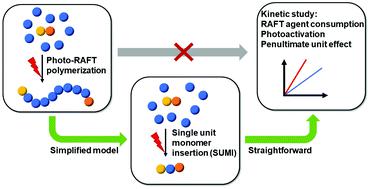当前位置:
X-MOL 学术
›
Polym. Chem.
›
论文详情
Our official English website, www.x-mol.net, welcomes your
feedback! (Note: you will need to create a separate account there.)
How does the single unit monomer insertion technique promote kinetic analysis of activation and initiation in photo-RAFT processes?
Polymer Chemistry ( IF 4.1 ) Pub Date : 2020-12-8 , DOI: 10.1039/d0py01413c Lei Zhang 1, 2, 3, 4 , Ruizhe Liu 1, 2, 3, 4 , Zixuan Huang 1, 2, 3, 4 , Jiangtao Xu 1, 2, 3, 4
Polymer Chemistry ( IF 4.1 ) Pub Date : 2020-12-8 , DOI: 10.1039/d0py01413c Lei Zhang 1, 2, 3, 4 , Ruizhe Liu 1, 2, 3, 4 , Zixuan Huang 1, 2, 3, 4 , Jiangtao Xu 1, 2, 3, 4
Affiliation

|
The reversible addition–fragmentation chain transfer (RAFT) agent plays a key role of “photo-iniferter” that is responsible for photo-initiation, chain transfer and termination in most photo-RAFT polymerization systems. With the merging of a visible light initiation method, photo-RAFT polymerization has achieved significant progress in the last decade. However, kinetic analysis is still less explored due to its inherent complexity in RAFT processes and photochemistry. Encouraged by previous works on thermally initiated RAFT polymerization, we herein investigate the kinetics of the early stage of the photo-RAFT process that comprises photo-activation of the initial RAFT agents and addition of RAFT leaving group radicals to the monomers. Apart from the complex kinetics, these reactions are generally too fast to investigate in RAFT polymerization. We employ the single unit monomer insertion (SUMI) technique to simplify and slow down these processes, in which chain propagation is absent. An in-depth look at the kinetics of the initiation process and establishment of kinetic models is thus possible. To this end, three model RAFT agents with the same terminal units and different penultimate units were synthesized and used as photo-iniferters for further single monomer additions. The effect of the penultimate units on the consumption rates of these RAFT agents has been demonstrated to be significant. A kinetic model accounting for various rate coefficients was developed to analyze the distinct rates of RAFT agent consumption. The kinetic rate equation reveals that the apparent RAFT consumption rate coefficient is positively correlated to the rate coefficients of photo-dissociation of the RAFT agents (kd) and radical-monomer addition (kp). Density functional theory calculation was performed to study the photo-activation and radical-monomer addition steps, implying that the reaction energies of these two steps are highly influenced by the penultimate units but in the opposite ways. For the contribution to overall RAFT agent consumption rates, the monomer addition is dominant.
中文翻译:

单单元单体插入技术如何促进光RAFT过程中活化和引发的动力学分析?
可逆的加成-断裂链转移(RAFT)剂起着“光引发剂”的关键作用,该光引发剂负责大多数光RAFT聚合体系中的光引发,链转移和终止。随着可见光引发方法的合并,在过去十年中,光-RAFT聚合取得了重大进展。然而,由于动力学分析在RAFT过程和光化学中固有的复杂性,因此仍然很少进行研究。受先前关于热引发的RAFT聚合的工作的鼓励,我们在此研究光-RAFT过程早期的动力学,该过程包括初始RAFT试剂的光活化和向单体中添加基团自由基的RAFT。除了复杂的动力学以外,这些反应通常太快,无法在RAFT聚合中进行研究。我们采用单单元单体插入(SUMI)技术来简化和减慢这些过程,因为其中没有链传播。因此,有可能深入研究引发过程的动力学并建立动力学模型。为此,合成了三种具有相同末端单元和不同倒数第二个单元的RAFT模型试剂,并将其用作光引发剂,用于进一步添加单个单体。已经证明倒数第二个单位对这些RAFT剂的消耗速率的影响是显着的。建立了考虑各种速率系数的动力学模型,以分析RAFT剂消耗的不同速率。k d)和自由基单体加成(k p)。进行密度泛函理论计算以研究光活化和自由基单体加成步骤,这表明这两个步骤的反应能量受倒数第二个单元的影响很大,但方向相反。为了对整个RAFT试剂消耗速率做出贡献,单体添加占主导地位。
更新日期:2020-12-24
中文翻译:

单单元单体插入技术如何促进光RAFT过程中活化和引发的动力学分析?
可逆的加成-断裂链转移(RAFT)剂起着“光引发剂”的关键作用,该光引发剂负责大多数光RAFT聚合体系中的光引发,链转移和终止。随着可见光引发方法的合并,在过去十年中,光-RAFT聚合取得了重大进展。然而,由于动力学分析在RAFT过程和光化学中固有的复杂性,因此仍然很少进行研究。受先前关于热引发的RAFT聚合的工作的鼓励,我们在此研究光-RAFT过程早期的动力学,该过程包括初始RAFT试剂的光活化和向单体中添加基团自由基的RAFT。除了复杂的动力学以外,这些反应通常太快,无法在RAFT聚合中进行研究。我们采用单单元单体插入(SUMI)技术来简化和减慢这些过程,因为其中没有链传播。因此,有可能深入研究引发过程的动力学并建立动力学模型。为此,合成了三种具有相同末端单元和不同倒数第二个单元的RAFT模型试剂,并将其用作光引发剂,用于进一步添加单个单体。已经证明倒数第二个单位对这些RAFT剂的消耗速率的影响是显着的。建立了考虑各种速率系数的动力学模型,以分析RAFT剂消耗的不同速率。k d)和自由基单体加成(k p)。进行密度泛函理论计算以研究光活化和自由基单体加成步骤,这表明这两个步骤的反应能量受倒数第二个单元的影响很大,但方向相反。为了对整个RAFT试剂消耗速率做出贡献,单体添加占主导地位。











































 京公网安备 11010802027423号
京公网安备 11010802027423号